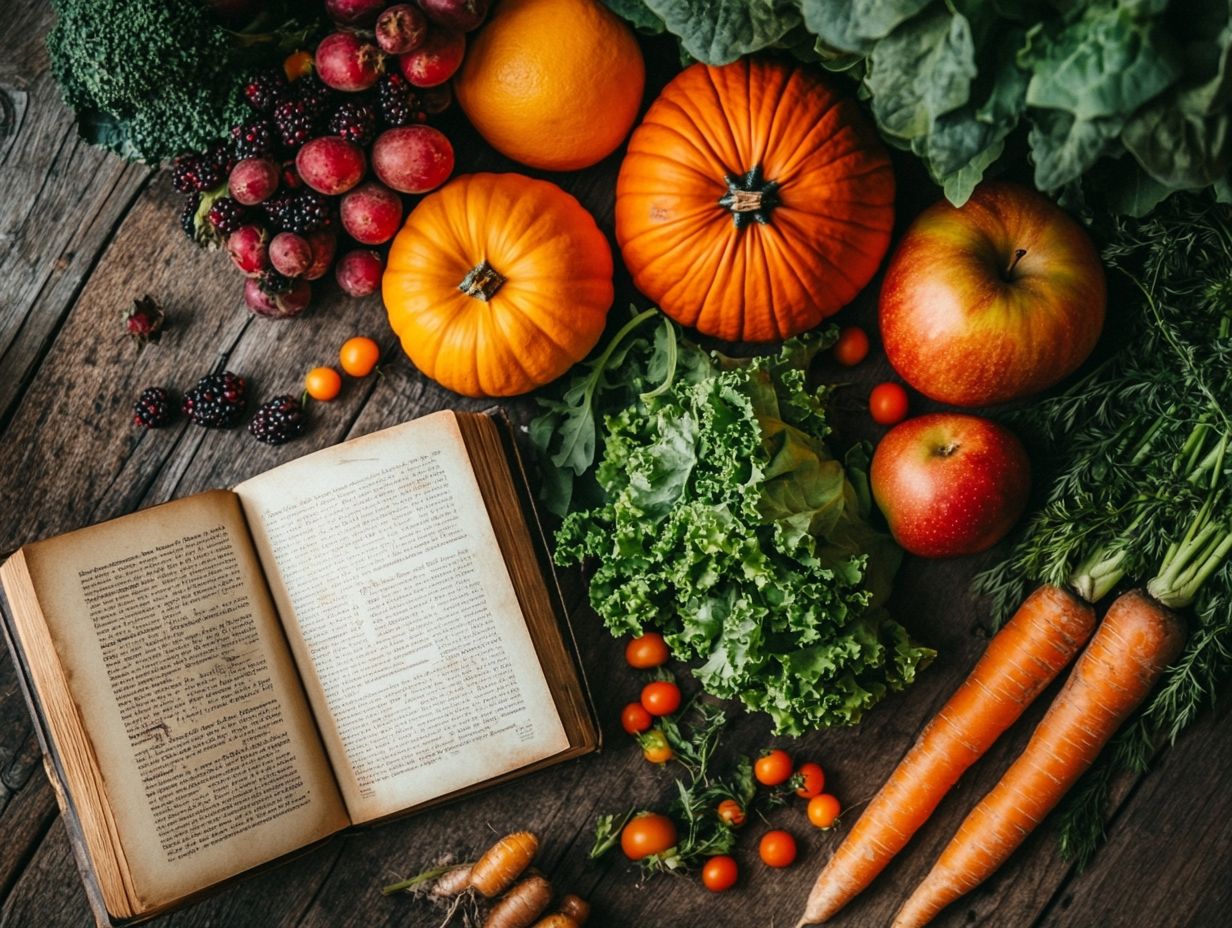How to Include Seasonal Foods in Meal Plans
Seasonal eating transcends mere trends; it embraces the rich bounty of nature s harvests, celebrating each season’s unique offerings. This way of eating encourages you to enjoy the flavors of seasonal foods while also providing numerous nutritional and environmental benefits.
You ll discover how to identify what s currently in season, access reliable resources, and creatively incorporate fresh ingredients into your cooking. Along the way, you’ll find a collection of delectable recipes designed to inspire your culinary adventures.
Immerse yourself in the world of seasonal eating and watch as it elevates both your meals and overall well-being!
Contents
- Key Takeaways:
- Benefits of Including Seasonal Foods in Meal Plans
- How to Identify Seasonal Foods
- Incorporating Seasonal Foods into Meal Planning
- Recipes Using Seasonal Ingredients
- Frequently Asked Questions
- What are seasonal foods?
- Why is it important to include seasonal foods in meal plans?
- How can I determine which foods are in season?
- What are some tips for incorporating seasonal foods into meal plans?
- Can I still enjoy my favorite foods if they are not in season?
- Are there any health benefits to including seasonal foods in meal plans?
Key Takeaways:
- Incorporating seasonal foods into meal plans offers both nutritional and environmental benefits.
- Identify seasonal foods through various resources such as farmers’ markets, online databases, and local produce guides.
- Incorporate a variety of recipes and use in-season ingredients for maximum flavor and nutrition.

What is Seasonal Eating?
Seasonal eating is a way of eating that encourages you to enjoy foods harvested at their peak freshness and flavor, along with local produce sourced from farmers’ markets or nearby farms.
This practice not only elevates the taste and nutritional value of your meals but also supports farming methods that help the environment, significantly reducing the carbon footprint associated with food transportation.
By focusing on seasonal ingredients, you can savor vibrant flavors and textures year-round, leading to healthier meals and a more enriching culinary journey.
Rooted in ancient agricultural traditions, seasonal eating celebrates the natural rhythms of life, inviting you to align your diet with what s available at different times of the year.
This is an exciting time for food lovers everywhere as many people seek a more meaningful connection to their meals.
Seasonal foods are essential for effective meal planning, unlocking creative recipes that reflect the artistry of Mediterranean cooking techniques.
Imagine preparing a delightful ratatouille with freshly harvested summer vegetables or a hearty winter minestrone packed with robust legumes and greens!
These culinary examples not only showcase the joy of cooking but also highlight the unique flavors that seasonal ingredients bring to your table, fostering a deeper appreciation for the food you consume.
Benefits of Including Seasonal Foods in Meal Plans
Including seasonal foods in your meal plans offers various advantages, from enhancing your health and nutrition to providing budget-friendly choices that elevate your culinary experience while supporting local agriculture.
Seasonal produce is often fresher and packed with nutrients, leading to heart-healthy meals that nourish your body. Choosing seasonal ingredients saves you money and is better for the planet.
This approach is particularly beneficial for low-income communities striving for healthy meal alternatives.
Nutritional and Environmental Advantages
The nutritional and environmental advantages of consuming seasonal foods are remarkable. These foods offer essential nutrients vital for your health while supporting sustainable farming practices.
When you choose fresh ingredients from local farmers, you’re often getting produce richer in vitamins compared to items that have traveled long distances, greatly enhancing the quality of your meals. Using frozen produce also reduces waste, giving you year-round access to many seasonal items without sacrificing their nutritional value.
Eating seasonally meets your body’s requirements for vitamins A, C, and E, along with minerals like potassium and magnesium. It also helps you connect more deeply with local ecosystems. Supporting your local farmers helps your community thrive!
To truly appreciate the vibrant flavors of fresh ingredients, try out different cooking techniques steaming, roasting, or grilling can bring out their natural tastes and textures beautifully. You can also use frozen produce in smoothies or soups, ensuring nutritious options are always available, even during the off-seasons.
Start your seasonal eating journey today! Discover new flavors and enjoy healthier meals!
How to Identify Seasonal Foods

Identifying seasonal foods involves a keen understanding of local growing seasons and can be easy by using tools like seasonal produce charts or meal reference guides that showcase what s currently available in your area.
Shopping at farmers’ markets or connecting directly with local farmers gives you valuable insights into which fruits and vegetables are in season and at their peak freshness.
Focusing your grocery shopping on seasonal ingredients not only streamlines your meal planning but also elevates your culinary experiences, infusing your dishes with vibrant flavors and freshness.
Resources for Locating Seasonal Produce
There are numerous resources available for locating seasonal produce, including online platforms, community-supported agriculture (CSA), and vibrant local farmers’ markets. These resources are invaluable for anyone looking to incorporate more fresh ingredients into their diet.
Connecting with local farmers helps you find the freshest seasonal foods. You ll also discover unique varieties that aren t available in regular grocery stores.
Websites like LocalHarvest and apps such as Farmigo connect you directly with nearby farms. These platforms often feature farm shares, allowing you to receive a weekly box brimming with fresh fruits and vegetables.
Exploring farmers’ markets lets you discover local offerings while fostering relationships with the growers. This connection deepens your knowledge about the produce and opens the door to valuable cooking suggestions.
Dive into a delightful array of seasonal flavors and create unique dishes that celebrate each season!
Incorporating Seasonal Foods into Meal Planning
Incorporating seasonal foods into your meal planning elevates both the flavor and nutritional quality of your dishes. To enhance your meals even further, check out how to incorporate superfoods into your meal plan. This approach also offers a streamlined method to grocery shopping.
This method simplifies the creation of diverse meal categories throughout the year. By prioritizing seasonal ingredients, you ll find unique recipe ideas that celebrate the dynamic bounty of fresh produce.
This enriches your culinary experience and cultivates a deeper connection to your meals and the environment.
Tips for Meal Planning with Seasonal Foods
When you plan meals with seasonal foods, being flexible in your recipe choices can significantly enrich your cooking experience. This approach allows you to use fresh ingredients and explore a variety of cooking techniques and flavors.
By prioritizing preparation steps that showcase seasonal produce, you can craft balanced meals tailored to your tastes and preferences.
To streamline your meal prep, consider batch cooking and prepping ingredients in advance. Washing, chopping, and storing vegetables in airtight containers can save you precious time during hectic weekdays. Plus, this practice encourages you to utilize fresh vegetables, enhancing both flavor and nutrition.
Experimenting with techniques like roasting or grilling seasonal items can elevate your meals, bringing out their natural sweetness and depth. Mixing contrasting textures like crunchy toppings on creamy soups can also add an exciting twist to wholesome dishes.
Encouraging creativity in the kitchen can transform your eating habits and make mealtime much more enjoyable for you and your family.
Recipes Using Seasonal Ingredients

Crafting delightful recipes with seasonal ingredients not only enhances the flavors but also invites you and your family to explore unique dishes that celebrate the diverse array of fresh produce available year-round.
Imagine Mediterranean-style grain bowls bursting with roasted vegetables or comforting stews that showcase the richness of winter ingredients. These meals can become cherished family favorites, nurturing both health and culinary creativity in your kitchen.
Delicious and Nutritious Meal Ideas
Seasonal ingredients can transform your meals. Enjoy delicious and nutritious ideas that elevate your dining experience.
Imagine vibrant grain bowls brimming with beans and peas, and fresh vegetables. Hearty vegetarian dishes seamlessly blend flavor and health.
Use cooking techniques like roasting and saut ing to create comforting meals that are enjoyable, easy to prepare, and gentle on your budget. Utilizing seasonal produce like butternut squash, kale, and sweet potatoes can elevate your dishes, turning them into a visual feast and a culinary delight.
Start your culinary journey with a warm pumpkin soup blended to velvety perfection, or serve roasted root vegetables drizzled with a sweet and tangy balsamic glaze as a savory side.
Encouraging creativity in the kitchen is key; don t hesitate to experiment with spices and herbs. A hint of smoked paprika or fresh basil can enhance flavors.
Don’t overlook fresh salads! They add a burst of flavor and texture, featuring crispy nuts and creamy avocado, completing any meal while ensuring a balanced intake of nutrients to promote your overall well-being.
Frequently Asked Questions
What are seasonal foods?
Seasonal foods are fresh ingredients harvested at specific times of the year. They are best in flavor and nutrition during their peak season.
Why is it important to include seasonal foods in meal plans?

Including seasonal foods in meal plans ensures that you consume fresh and nutrient-rich ingredients while supporting local farmers and businesses. Seasonal foods are often more affordable and environmentally sustainable compared to out-of-season produce.
How can I determine which foods are in season?
Check your local farmers market or an online seasonal food guide to find out what’s in season. Remember that seasonal foods can vary depending on your location and climate.
What are some tips for incorporating seasonal foods into meal plans?
Plan your meals around what’s in season to stay organized and use fresh ingredients. Try new recipes featuring seasonal produce, preserve seasonal foods by freezing or canning, and buy in bulk for future meal plans.
Can I still enjoy my favorite foods if they are not in season?
Yes, you can still enjoy your favorite foods even if they are not in season. However, they may not be as fresh or flavorful. Consider finding substitutes for out-of-season produce or opt for frozen or canned options preserved during their peak season.
Are there any health benefits to including seasonal foods in meal plans?
Yes, there are several health benefits to including seasonal foods in meal plans. Seasonal foods are typically fresher, retaining more nutrients than out-of-season produce. They are often lower in pesticides and other harmful chemicals, as they are grown and harvested in their natural environment.
Try incorporating seasonal foods into your meals this week! Discover fresh flavors and support local farmers.






